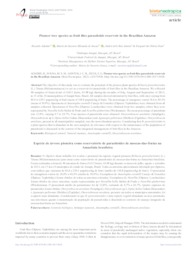Pioneer tree species as fruit flies parasitoids reservoir in the Brazilian Amazon.
Pioneer tree species as fruit flies parasitoids reservoir in the Brazilian Amazon.
Autoria: ADAIME, R.; SOUSA, M. S. M.; SANTOS, J. C. R.; DEUS, E. G.
Resumo: The objective of this study was to evaluate the potential of the pioneer plant species Bellucia grossularioides (L.) Triana (Melastomataceae) to act as a reservoir for parasitoids of fruit flies in the Brazilian Amazon. We collected 48 samples of fruits (total of 4,012 fruits, 43.98 kg) during the months of July, August and September of 2013, in 15 of the 16 municipalities of Amapá State, Brazil. All samples showed infestation by fruit flies, with rates varying from 60.6 to 239.1 puparia/kg of fruit (mean of 106.8 puparia/kg of fruit). The percentage of emergence varied 18.6 to 64.3% (mean of 39.9%). Specimens of Anastrepha coronilli Carrejo & González (Diptera: Tephritidae) were obtained from all samples collected. Specimens of Neosilba (Diptera: Lonchaeidae) were obtained from five samples, where they were represented by Neosilba bella Strikis & Prado and Neosilba glaberrima (Wiedemann). The mean percentage of parasitism was 12.8%, varying 4.7 to 26.7%. Four species of parasitoids were obtained: Doryctobracon areolatus Szépligeti), Doryctobracon sp.2, Opius bellus Gahan (Braconidae) and Aganaspis pelleranoi (Brèthes) (Figitidae). Doryctobracon areolatus, present in all municipalities sampled, was the most abundant species. Considering that B. grossularioides is a plant species that is abundant in the area sampled, its relevance with respect to the maintenance of the population of parasitoids is discussed in the context of the integrated management of fruit flies in the Amazon.
Ano de publicação: 2018
Tipo de publicação: Artigo de periódico
Unidade: Embrapa Amapa
Observações
1 - Por padrão são exibidas publicações dos últimos 20 anos. Para encontrar publicações mais antigas, configure o filtro ano de publicação, colocando o ano a partir do qual você deseja encontrar publicações. O filtro está na coluna da esquerda na busca acima.
2 - Para ler algumas publicações da Embrapa (apenas as que estão em formato ePub), é necessário ter, no celular ou computador, um desses softwares gratuitos. Sistemas Android: Google Play Livros; IOS: iBooks; Windows e Linux: software Calibre.
Acesse outras publicações
Acesse a Base de Dados da Pesquisa Agropecuária (BDPA) para consultar o acervo completo das bibliotecas da Embrapa.

